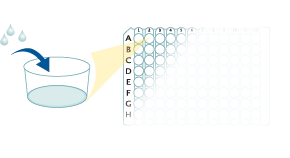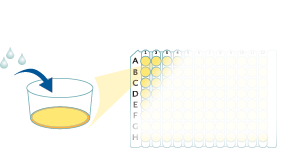Mouse CXCL13/BLC/BCA-1 Quantikine ELISA Kit Summary
Product Summary
Recovery
The recovery of mouse BLC/BCA-1 spiked to three levels throughout the range of the assay in various matrices was evaluated.
| Sample Type | Average % Recovery | Range % |
|---|---|---|
| Cell Culture Supernates (n=4) | 93 | 83-109 |
| EDTA Plasma (n=7) | 98 | 80-115 |
| Heparin Plasma (n=4) | 96 | 80-110 |
| Serum (n=7) | 104 | 85-119 |
Linearity
Scientific Data
Product Datasheets
Preparation and Storage
Background: CXCL13/BLC/BCA-1
CXCL13/BLC/BCA-1 is a constitutively expressed chemokine that plays an important role in B and T cell homing. It is expressed by salivary gland epithelium, dendritic cells, osteoclasts, and peritoneal macrophages. It can form homodimers or heterodimers with FGF basic, and it signals through CXCR3 or CXCR5. CXCL13 induces the migration of naïve B cells and a subset of memory T cells to lymphoid tissue. It also promotes B1 cell migration into the omentum and peritoneum. In the fetus, CXCL13 attracts CD4+ CD3- IL-7 R alpha+ hematopoietic cells to sites of future Peyer’s patch development.
Assay Procedure
Refer to the product- Prepare all reagents, standard dilutions, and samples as directed in the product insert.
- Remove excess microplate strips from the plate frame, return them to the foil pouch containing the desiccant pack, and reseal.
- Add 50 µL of Assay Diluent to each well.
- Add 50 µL of Standard, Control, or sample to each well. Cover with a plate sealer, and incubate at room temperature for 2 hours on a horizontal orbital microplate shaker.
- Aspirate each well and wash, repeating the process 4 times for a total of 5 washes.
- Add 100 µL of Conjugate to each well. Cover with a new plate sealer, and incubate at room temperature for 2 hours on the shaker.
- Aspirate and wash 5 times.
- Add 100 µL Substrate Solution to each well. Incubate at room temperature for 30 minutes on the benchtop. PROTECT FROM LIGHT.
- Add 100 µL of Stop Solution to each well. Read at 450 nm within 30 minutes. Set wavelength correction to 540 nm or 570 nm.





Citations for Mouse CXCL13/BLC/BCA-1 Quantikine ELISA Kit
R&D Systems personnel manually curate a database that contains references using R&D Systems products. The data collected includes not only links to publications in PubMed, but also provides information about sample types, species, and experimental conditions.
17
Citations: Showing 1 - 10
Filter your results:
Filter by:
-
Quinic acid regulated TMA/TMAO-related lipid metabolism and vascular endothelial function through gut microbiota to inhibit atherosclerotic
Authors: Jin, Q;Zhang, C;Chen, R;Jiang, L;Li, H;Wu, P;Li, L;
Journal of translational medicine
Species: Transgenic Mouse
Sample Types: Serum
-
Upregulation of IL4-induced gene 1 enzyme by B2 cells during melanoma progression impairs their antitumor properties
Authors: Bekkat, F;Seradj, M;Lengagne, R;Fiore, F;Kato, M;Lucas, B;Castellano, F;Molinier-Frenkel, V;Richard, Y;Prévost-Blondel, A;
European journal of immunology
Species: Mouse
Sample Types: Cell Lysates
-
Radiofrequency Ablation Remodels the Tumor Microenvironment and Promotes Neutrophil-Mediated Abscopal Immunomodulation in Pancreatic Cancer
Authors: EY Faraoni, BJ O'Brien, LN Strickland, BK Osborn, V Mota, J Chaney, CL Atkins, P Cen, J Rowe, J Cardenas, KL Poulsen, CJ Wray, NC Thosani, JM Bailey-Lun
Cancer Immunology Research, 2023-01-03;11(1):4-12.
Species: Mouse
Sample Types: Serum
-
Glutathione-dependent redox balance characterizes the distinct metabolic properties of follicular and marginal zone B cells
Authors: DG Franchina, H Kurniawan, M Grusdat, C Binsfeld, L Guerra, L Bonetti, L Soriano-Ba, A Ewen, T Kobayashi, S Farinelle, AR Minafra, N Vandamme, A Carpentier, FK Borgmann, C Jäger, Y Chen, M Kleinewiet, V Vasiliou, M Mittelbron, K Hiller, PA Lang, D Brenner
Nature Communications, 2022-04-04;13(1):1789.
Species: Mouse
Sample Types: Serum
-
Gas6 induces inflammation and reduces plaque burden but worsens behavior in a sex-dependent manner in the APP/PS1 model of Alzheimer's disease
Authors: LD Owlett, B Karaahmet, L Le, EK Belcher, D Dionisio-S, JA Olschowka, MR Elliott, MK O'Banion
Journal of Neuroinflammation, 2022-02-07;19(1):38.
Species: Mouse
Sample Types: Tissue Homogenates
-
The Nutritional Supplement L-Alpha Glycerylphosphorylcholine Promotes Atherosclerosis
Authors: Z Wang, J Hazen, X Jia, E Org, Y Zhao, LJ Osborn, N Nimer, J Buffa, MK Culley, D Krajcik, BH van den Bo, K Zwinderman, BS Levison, M Nieuwdorp, AJ Lusis, JA DiDonato, SL Hazen
International Journal of Molecular Sciences, 2021-12-15;22(24):.
Species: Mouse
Sample Types: Plasma
-
Suppressing neutrophil-dependent angiogenesis abrogates resistance to anti-VEGF antibody in a genetic model of colorectal cancer
Authors: Y Itatani, T Yamamoto, C Zhong, AA Molinolo, J Ruppel, P Hegde, MM Taketo, N Ferrara
Proc. Natl. Acad. Sci. U.S.A., 2020-08-19;0(0):.
Species: Mouse
Sample Types: Serum
-
Dual-mechanism based CTLs infiltration enhancement initiated by Nano-sapper potentiates immunotherapy against immune-excluded tumors
Authors: Y Huang, Y Chen, S Zhou, L Chen, J Wang, Y Pei, M Xu, J Feng, T Jiang, K Liang, S Liu, Q Song, G Jiang, X Gu, Q Zhang, X Gao, J Chen
Nat Commun, 2020-01-30;11(1):622.
Species: Mouse
Sample Types: Tissue Homogenates
-
GM-CSF Promotes Chronic Disability in Experimental Autoimmune Encephalomyelitis by Altering the Composition of Central Nervous System-Infiltrating Cells, but Is Dispensable for Disease Induction
Authors: PC Duncker, JS Stoolman, AK Huber, BM Segal
J. Immunol., 2017-12-29;0(0):.
Species: Mouse
Sample Types: Tissue Homogenates
-
Brain inflammation is accompanied by peripheral inflammation in Cstb (-/-) mice, a model for progressive myoclonus epilepsy
J Neuroinflammation, 2016-11-28;13(1):298.
Species: Mouse
Sample Types: Serum
-
Hif1a Deletion Reveals Pro-Neoplastic Function of B Cells in Pancreatic Neoplasia
Cancer Discov, 2015-12-29;6(3):256-69.
Species: Mouse
Sample Types: Tissue Homogenates
-
Prion infection of mouse brain reveals multiple new upregulated genes involved in neuroinflammation or signal transduction.
Authors: Carroll J, Striebel J, Race B, Phillips K, Chesebro B
J Virol, 2014-12-10;89(4):2388-404.
Species: Mouse
Sample Types: Tissue Homogenates
-
Repetitive hypoxic preconditioning induces an immunosuppressed B cell phenotype during endogenous protection from stroke.
Authors: Monson N, Ortega S, Ireland S, Meeuwissen A, Chen D, Plautz E, Shubel E, Kong X, Li M, Freriks L, Stowe A
J Neuroinflammation, 2014-01-31;11(0):22.
Species: Mouse
Sample Types: Tissue Homogenates
-
Lymphotoxin beta receptor signaling promotes tertiary lymphoid organogenesis in the aorta adventitia of aged ApoE-/- mice.
Authors: Grabner R, Lotzer K, Dopping S, Hildner M, Radke D, Beer M, Spanbroek R, Lippert B, Reardon CA, Getz GS, Fu YX, Hehlgans T, Mebius RE, van der Wall M, Kruspe D, Englert C, Lovas A, Hu D, Randolph GJ, Weih F, Habenicht AJ
J. Exp. Med., 2009-01-12;206(1):233-48.
Species: Mouse
Sample Types: Serum
-
Cyclooxygenase inhibition during allergic sensitization increases STAT6-independent primary and memory Th2 responses.
Authors: Zhou W, Newcomb DC, Moore ML, Goleniewska K, O'Neal JF, Peebles RS
J. Immunol., 2008-10-15;181(8):5360-7.
Species: Mouse
Sample Types: Tissue Homogenates
-
Therapeutic targeting of CC ligand 21 or CC chemokine receptor 7 abrogates pulmonary fibrosis induced by the adoptive transfer of human pulmonary fibroblasts to immunodeficient mice.
Authors: Pierce EM, Carpenter K, Jakubzick C, Kunkel SL, Flaherty KR, Martinez FJ, Hogaboam CM
Am. J. Pathol., 2007-04-01;170(4):1152-64.
Species: Mouse
Sample Types: Tissue Homogenates
-
The chemokine decoy receptor M3 blocks CC chemokine ligand 2 and CXC chemokine ligand 13 function in vivo.
Authors: Martin AP, Canasto-Chibuque C, Shang L, Rollins BJ, Lira SA
J. Immunol., 2006-11-15;177(10):7296-302.
Species: Mouse
Sample Types: Cell Culture Supernates
FAQs
No product specific FAQs exist for this product, however you may
View all ELISA FAQsReviews for Mouse CXCL13/BLC/BCA-1 Quantikine ELISA Kit
There are currently no reviews for this product. Be the first to review Mouse CXCL13/BLC/BCA-1 Quantikine ELISA Kit and earn rewards!
Have you used Mouse CXCL13/BLC/BCA-1 Quantikine ELISA Kit?
Submit a review and receive an Amazon gift card.
$25/€18/£15/$25CAN/¥75 Yuan/¥2500 Yen for a review with an image
$10/€7/£6/$10 CAD/¥70 Yuan/¥1110 Yen for a review without an image





